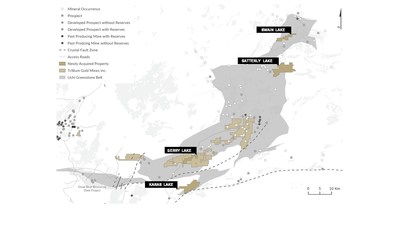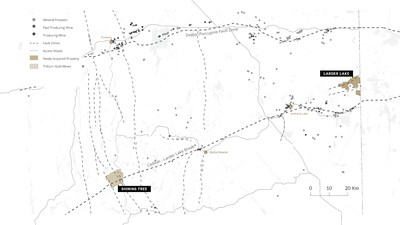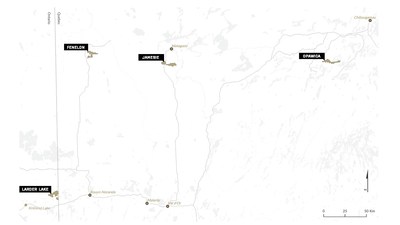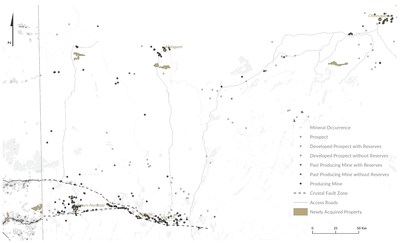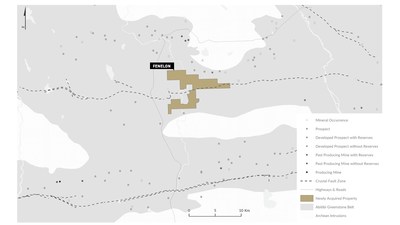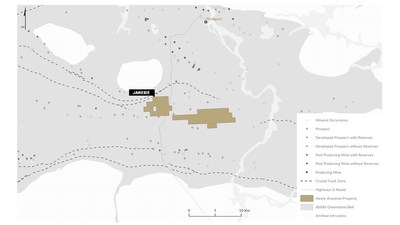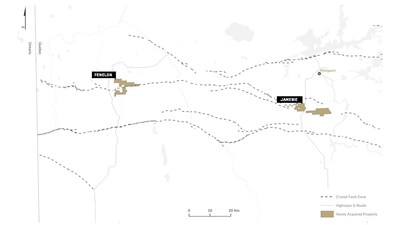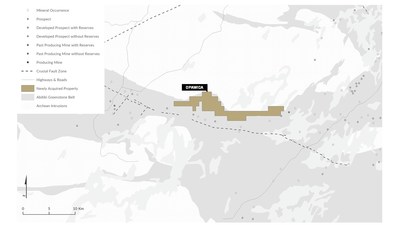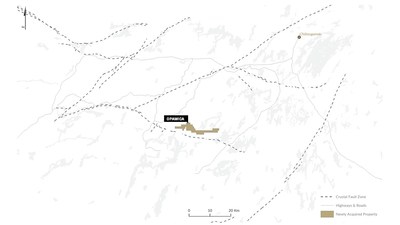- Consolidates an additional 7,939 hectares in the Confederation Lake and Birch-Uchi Greenstone Belts of the Red Lake District
- Acquires highly prospective Larder Lake Property including extension of the Kirkland Lake Fault amid neighbours Agnico Eagle Mines and New Found Gold
- Adds three Quebec properties in very active exploration camps
Trillium Gold Mines Inc. (TSXV: TGM) (OTCQX: TGLDF) (FRA: 0702) (“Trillium” or the “Company”) is excited to announce that it has completed additional acquisitions of highly prospective property in the Confederation Lake and Birch-Uchi greenstone belts in the Red Lake District as well as properties in Larder Lake, Ontario and in the Matagami and Chibougamou areas of Quebec.
Russell Starr, CEO of Trillium Gold comments “The Trillium team is committed to building district-scale opportunities for TGM shareholders. We have grown substantially in a short period of time and now the exciting period for all shareholders begins – the drilling and discovery phase.
With a robust treasury, a 35,000 meter drill program and exceptional green field exploration potential, Trillium Gold is positioned to be a dominant player in the world-class Red Lake gold district which will be the main driver for shareholder value.
In addition, the extension of our asset base into the Larder Lake gold camp includes a 12 km strike length along the eastern extension of the highly mineralized Kirkland Lake Fault, and into Quebec where our Fenelon property is situated approximately 65 km southeast of Detour Lake and within 7 km south of BHP’s historic Selbaie Mine, one of the largest producers of zinc, copper, gold and silver concentrates in the late 1990’s. The Jamesie Property located less than 20 km due south of Matagami and 160 km north of Val d’Or where Glencore holds a large property east and north, is also contiguous to Eldorado Gold’s property to the west and displays the same structures and geology. These new acquisitions have seen limited exploration and represent considerable potential for future shareholder value.”
Confederation Belt Properties:
Karas Lake
The Karas Lake property comprises 5 claims covering 2,222 hectares in the Confederation Lake greenstone belt.
Regional scale mapping indicates that the core of the property is underlain by a sequence of northeast trending metavolcanic rocks, primarily consisting of mafic flows, with lesser amounts of felsic pyroclastic rocks and metasediments occurring along the southeast property boundary. The metavolcanic sequence is flanked by the Bruce Lake Stock to the northwest and the Bluffy Lake Batholith to the southeast.
The property is located on a flexure in the regional-scale Sydney Lake Fault, which cuts the lithologies near the contact of the Bluffy Lake batholith and metavolcanic rocks.
Along strike immediately east of the property boundary, shallow diamond drilling by Selco in the late 1970’s intersected several narrow conductive horizons containing 10-20% sulphide mineralization (pyrite/pyrrhotite). Immediately west of the property, Ontario Geological Survey (OGS) maps show an iron formation in the mafic volcanic unit trending onto the property that has been mapped over a 3.5 km strike length.
No previous exploration work has been documented on the Karas property and exploration on adjacent properties has been focused on iron and base metal-style mineralization. Based on regional-scale geological features, Trillium’s exploration efforts on the Karas Lake property will seek to identify (Au) targets, with a focus on LP Fault-style and Musselwhite-style mineralization.
Gerry Lake
Trillium further consolidated its land position in the Confederation Belt with the acquisition of the Gerry Lake property (2 claims covering 836 hectares), which forms a bridge between their recently acquired Joy and Copperlode properties. The Confederation Belt properties are underlain by metavolcanic rocks with intense volcanogenic massive sulphide-style (VMS) alteration and are host to numerous mineralized VMS zones on two parallel horizons (see Trillium Gold Mines News Release, Nov 23, 2020 ).
Birch-Uchi Properties:
The discovery of gold at Red Lake in 1926 precipitated approximately 10 years of extensive prospecting activity in the Birch-Uchi greenstone belt, which led to the discovery of numerous showings and several mines. Exploration activity has continued intermittently at moderate to high levels over the past 100 years. Despite the volume of work conducted, the advancement of exploration technologies and mineralization models continue to yield exciting new discoveries in the belt, such as Prosper Gold’s Golden Corridor, which lies 25 km west of the Satterly Lake property.
Satterly Lake
The Satterly Lake property is located approximately 90 km east of Red Lake. It comprises 8 contiguous claims (3,049 ha) underlain by felsic metavolcanic and coarse clastic metasedimentary rocks of the Birch-Uchi greenstone belt. The highly prospective Grace Lake Deformation Zone transects the southwest portion of the property. This D 2 shear zone is interpreted as a splay off the northeast trending Swain Lake Deformation Zone, both of which host numerous gold occurrences to the west of the property.
The Satterly Lake property is relatively unexplored, but several mineral occurrences documented on adjacent properties have potential to extend along strike onto the property. Located only 1.5 km off the western boundary, the Sol D’Or Mine produced 256 ounces of gold and 33 ounces of silver (Ag) between 1933 and 1936 from 232 tonnes of ore grading 19.2 grams per tonne (g/t) Au (458 tons at 0.56 ounces per ton (opt) Au). Ore zones were described as east-trending mineralized quartz veins in felsic tuffs. According to historical government records, the estimated reserves on the property in 1936 were 7,770 tonnes at 19.5 g/t Au (8,565 tons @ 0.57 opt Au) (OGS Open File Report 5835, 1989) – the Qualified Person has not done sufficient work to classify this historical estimate as a current resource. The company is not treating the historical estimate as a current resource.
The Hanson gold occurrence, discovered in 1947, is located 1 km north of the property. The best historical results reported were 6.2 g/t Au over a 1.5m drill intercept in mineralized diorite and 18.5 g/t Au from a grab sample. Just 500m further north, the Loydex copper-zinc occurrence was discovered by Noranda in 1985. Diamond drilling intersected multiple zones in a quartz-diorite intrusive with alteration and indicator mineralization commonly associated with gold including narrow chlorite and carbonate altered shear zones with up to 2% sulphide minerals (pyrrhotite, pyrite), silicified zones with 10% disseminated pyrite, 2m wide zones containing 20-30% quartz-carbonate veinlets having 5-10% pyrite, pyrrhotite, magnetite, and tourmaline along the margins; arsenopyrite veinlets, and an 8m wide zone with strong sericitization. No assay results were reported from this drilling.
To the east of the Satterly Lake property lies Falcon Gold’s Springpole West property, where in 1979 Sherritt Gordon Mines Ltd. intersected 19.40 g/t Au over 30cm in a diamond drill hole within a gold-bearing, silicified, property-wide fault zone hosted in a quartz vein-stockwork system. Massive sulphide pods were also encountered along the fault zone with significant zinc, silver, and gold values.
Swain Lake
The 46 claim 1,832 hectare Swain Lake property is located 8 km northwest of First Mining’s Springpole Lake property, which is reported as one of the largest undeveloped gold projects in Canada. First Mining’s Preliminary Economic Assessment (“PEA”), completed in November 2019, reported an Indicated Resource of 4,670,000 ounces of Au and 24,190,000 ounces of Ag from 139.1 Mt of ore grading 1.04 g/t Au and 5.4 g/t Ag, as well as an Inferred Resource of 11.4 million tonnes averaging 0.63 g/t Au and 3.1 g/t Ag, containing 230,000 ounces of Au and 1,120,000 ounces of Ag.
The Swain Lake property encompasses a nine-kilometre stretch of the Swain Lake Deformation Zone (SLDF), over a gentle flexure point where the strike changes from a northeast trend to more easterly. Numerous gold occurrences are documented along the strike of this regional-scale structure.
To the north of the SLDF, the property is underlain by mafic-intermediate metavolcanic rocks and gabbro. To the south lie felsic metavolcanic rocks that strike northeast and dip subvertically. Proximal to the SLDF, intense strain and deformation produce a gossaneous quartz-sericite-ankerite-pyrite schist with associated fracture zones commonly filled with quartz-ankerite-(tourmaline) veining and trace to 5% disseminated pyrite.
Mineral exploration conducted on the property in the 1970s and 1990s included mapping, geochemical sampling, trenching and 2 diamond drill holes totalling approximately 400m in depth. Although no economic mineralization was identified from the earlier programs, structural, alteration and mineralogical indicators suggest further investigation is warranted.
Other notable mineral deposits/occurrences within a six-kilometre radius of the Swain Lake property include:
- The Argosy Mine: milled 250,900 Mt of ore grading 12.63 g/t to produce 101,875 ounces of gold between 1934 to 1952
- Richardson Lake: reported to have produced 1126 ounces oz Au and 102 oz Ag from 577 tonnes grading 60.7 g/t Au. An unclassified historical resource of 635,000 tonnes grading 6.86 g/t was calculated by Golden Terrace Resources Corp and published in the Northern Miner; June 20, 1988
- The MacIntyre Mine: reported to have produced 23 ounces of gold in 1934-35 from gold-bearing quartz-tourmaline veins accompanied by arsenopyrite, pyrite and chalcopyrite along shears in mafic to intermediate volcanic rocks
- First Mining’s Horseshoe Island prospect: a historical unclassified resource of 810,500 t grading 4.8 g/t Au (OGS MDI record 52N08NW00020)
Larder Lake
Larder Lake Property
The Larder Lake Property (14 claims covering 4,630 hectares in 2 separate blocks) covers favourable fault structures within the Larder Lake gold camp, including a 12 km strike length along the easterly trending Misema-Mist Lake Fault, an eastern extension of the highly mineralized Kirkland Lake Fault, plus two N-NW trending cross structures, totalling an additional 4 km in length. The property’s eastern boundary is also the Ontario – Quebec provincial boundary.
The southern property boundary encompasses the easterly and westerly extensions of the Ossian Prospect. Historical work between 1924 to 1938 includes trenching, diamond drilling and sinking of a two-compartment exploration shaft to 64m (210 ft) depth and 240m (800 ft) of development on 2 levels. The prospect was described as an east-trending quartz vein containing sericite, calcite and pyrite traced over 120m in a felsic porphyry host rock. This vein returned assays up to 21.5 g/t Au over 1.23m (0.63 opt over 4 feet) from channel sampling.
Most of the previous exploration work on the Larder Lake property focussed on tracing the Ossian Prospect mineralization to the east. A 1996 reverse circulation drill program completed by Silver Century Explorations Ltd., indicated slightly elevated pristine and modified gold grain counts from 2 holes in the southeast portion of the property, suggesting a proximal to intermediate source of gold. Follow up work in 1997 included ground geophysical surveys, geological mapping/sampling and diamond drilling. One diamond drill hole testing an IP anomaly was completed on Trillium Gold’s current property. Gold mineralization was not encountered in this drill hole.
The Walsh Mine prospect (Newfound Gold) is located 3 km south of the property. The primary mineralized zone is described as NE-striking quartz-ankerite veins traced 400m along strike and up to 1.5m width, containing pyrite, chalcopyrite, specularite, and galena. In 1924, a two-compartment shaft was sunk to a depth of 157m with lateral development on 4 levels. Two bulk samples collected in 1933 assayed 3.77 g/t Au (0.11 opt) and 64.1 g/t Au (1.87 opt), respectively. One of the better results of diamond drilling by Canper Resources Inc. in 1986 was 47.29 g/t Au over 2.5 feet.
Quebec
SW Fenelon
The 25 claim SW Fenelon property (3,459 ha) is 140 km NNW of Amos, Quebec , and 65 km SE of Detour Lake. Soquem is contiguous to the north claim boundary, Wallbridge Mining and Midland Exploration are due west of the property, and Yourbeau Exploration is to the east. The property is located less then 7km south of the historic Selbaie Mine. The Selbaie Mine, owned by BHPBilliton, was closed in January 2004. Selbaie was discovered in 1974 as a result of drilling on an electromagnetic anomaly identified in an airborne Input survey flown in 1971. It was one of the largest producers of zinc, copper, gold and silver concentrates in Québec and by the end of 1996, underground operations in the A2 and B had mined 7.0 million tonnes of ore, and open pit operations in the A1 zone had mined 23.8 million tonnes of ore. Average grades were 2.02% zinc, 1.22% copper, 0.65 g/t gold, and 43.24 g/t silver. Limited exploration has been completed on the property.
Jamesie
The Jamesie Property covers 4,062 ha in 73 claims and is less than 20 km due south of Matagami, and 160 km north of Val d’Or, Quebec, straddling Provincial Hwy 109. Glencore PLC holds a large property east and north of the Jamesie Property, extending to Matagami. Eldorado Gold is contiguous to the west and Midlands Exploration is contiguous to the south.
The property has seen limited exploration historically. Eldorado Gold’s property to the west covers nearly 50km of strike length with the same structures and geology as the Jamesie Property.
Opawica
The Opawica Property (33 claims, 3,677 ha) is 67 km southwest of Chibougamau and 32 km south of Chapais in Quebec. The primary neighbour of the property is BTM Corporation, which controls a large land package between the Opawica Property and IAMGOLD’s Monster Lake Deposit. There is very limited exploration either on the property or along strike.
The Company entered into an option agreement with the vendors, pursuant to this option agreement the Company has been granted an option to acquire the properties. In order to acquire all of the properties under the option agreement, the Company is required to pay aggregate consideration of $618,200 over a period of three years, issue an aggregate 410,000 common shares and grant to the vendors a 1.5% net smelter royalty over each of the properties acquired. The Company has the right to repurchase 50% of each royalty by paying the holder $500,000 per royalty.
The technical information presented in this news release has been reviewed and approved by William Paterson QP, PGeo, VP of Exploration of Trillium Gold Mines, as defined by NI 43-101.
For further information about this news release and the Company’s current activities contact info@trilliumgold.com , visit our website at www.trilliumgold.com or call us at 604-688-9588.
On behalf of the Board of Directors,
Trillium Gold Mines Inc.
“Russell Starr”
Russell Starr
President, CEO and Director
About Trillium Gold Mines Inc.
Trillium Gold Mines Inc. is a British Columbia based company engaged in the business of acquisition, exploration and development of mineral properties located in the highly prospective Red Lake Mining District of Northern Ontario.
Disclosure and Caution
Neither TSX Venture Exchange nor its Regulation Services Provider (as that term is defined in the policies of the TSX Venture Exchange) accepts responsibility for the adequacy or accuracy of this release.
This news release contains forward-looking information, which involves known and unknown risks, uncertainties and other factors that may cause actual events to differ materially from current expectation. Readers are cautioned not to place undue reliance on these forward-looking statements, which speak only as of the date of this press release. The Company disclaims any intention or obligation, except to the extent required by law, to update or revise any forward-looking statements, whether as a result of new information, future events or otherwise.
Source: Trillium Gold Mines Inc.
Trillium Gold Mines Inc. is a client and sponsor of PinnacleDigest.com.
